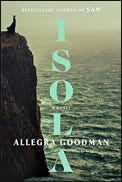Isola is about Marguerite de Roberval, the orphaned heir to a nobleman’s estate in sixteenth-century France. Underage and unmarried, she is at the mercy of her guardian, her father’s cousin Jean-François de Roberval. He manages the estate to profit himself and pay for the sea voyages he hopes will make him wealthy, while keeping Marguerite and her servants on a stingy budget, demanding their gratitude for every small outlay of funds on their behalf.
The prologue and especially the jacket copy does this novel a disservice by emphasizing that Marguerite will be cast off on a deserted island where she must survive alone. But it’s not until halfway through that she and two companions are left on the isle, and not until later that she finds herself alone. While the second half of the novel is the most interesting, there is plenty in the first half to engage a reader who isn’t waiting impatiently to reach that deserted island.
The lives of even the most privileged women in late medieval France were hedged about with limitations and demands for a piety that emphasized subservience and self-abasement. Section headings quote from the 1517 book Lessons for My Daughter by Anne of France, herself a daughter of King Louis XI. It includes such instructions as “Understand that if even a small fault or untruth were to be found in you, it would be a great disgrace.” Marguerite takes ideas like this to heart, but gradually develops a backbone that serves her well when fate deals its harshest blows.
The character of Marguerite is based on a historical woman of the same name, about whom little is known except that she survived for two years marooned on an island in the Gulf of Saint Lawrence. Goodman’s novel imagines how she could have done it. As Marguerite takes baby steps, and then brave leaps, toward gaining a measure of control over her own life, she becomes a character worth cheering on. Since her journey toward self-assertion makes her survival possible, the first half of the novel is vital background for the second. (2025, 339 pages, plus an author’s note and bibliography about the history behind the fiction)




